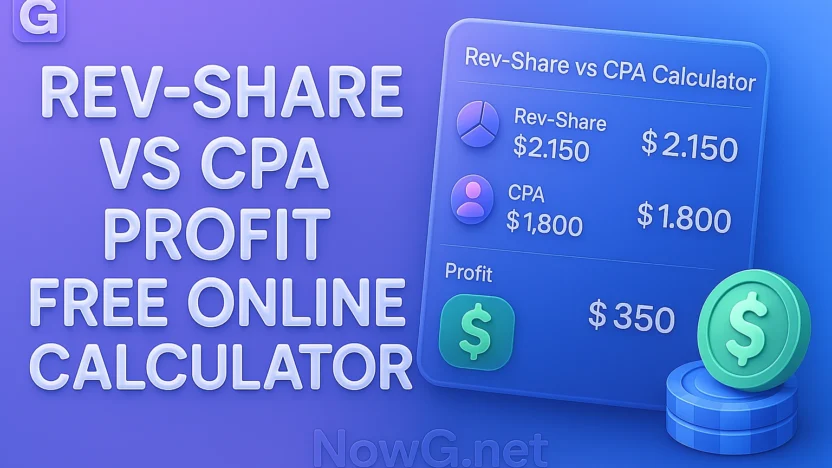Last Updated on August 23, 2025 by Caesar Fikson
Rev‑share vs CPA profit calculator. This tool lets affiliates input expected player value, conversion rates and commission structures to decide which payout model is more profitable.
Rev-Share vs CPA: Which Pays You More for iGaming Traffic?

Choosing between revenue share and CPA isn’t a vibes decision; it’s math. The right model depends on your FTD rate, player LTV/NGR, voids/chargebacks, and media costs. Use the calculator above to model casino and sportsbook traffic, then pressure-test your assumptions before signing a deal.
How the calculator works (in plain English)
- Inputs you control: Clicks, FTD rate, cost per click, LTV / NGR per FTD (lifetime or monthly with decay), CPA, rev-share %, and void/adjustment rates.
- Outputs you care about: Estimated FTDs, Revenue, Net Profit, Revenue per Click (RPC), ROI, and break-even points (the CPA that equals your rev-share value, and the rev-share % that equals your CPA).
Quick example (typical casino numbers)
- Traffic: 10,000 clicks, FTD rate 1.5% → 150 FTDs
- CPA: €200 with 5% void → €190/FTD → €28,500 revenue
- Rev-share: 30% of €800 LTV with 8% adjustment → €220.8/FTD → €33,120 revenue
Result: Rev-share beats CPA by €4,620 on revenue (profit delta identical if traffic cost is the same). If your CPC > 0, check ROI—rev-share typically shines as retention improves.
When CPA wins
- Low retention or bonus tourists (short LTV).
- Aggressive paid acquisition where cash-flow speed matters.
- You’re testing a new GEO or partner and want risk off.
- Operator enforces negative carryover or heavy deductions on rev-share.
When Rev-Share wins
- Sticky verticals and strong CRM (higher LTV/NGR).
- High-intent organic rankings: brand + bonus queries that convert and retain.
- Seasonality and cross-sell (casino ↔ sportsbook) increase lifetime value.
- You can reach commission tiers or add sub-aff revenue on top.
Hybrid deals (CPA + Rev-Share)
- Use the tool to set your break-even CPA given your rev-share assumptions.
- If an operator offers CPA lower than your break-even, plus even a modest rev-share, you’ve bought downside protection and kept upside.
- Watch the small print: qualification thresholds, time-bound RS, or caps can erase expected value.
Levers that swing results
| Lever | Why it matters | What to check |
|---|---|---|
| FTD rate | Drives volume into either model | Landing page, GEO intent, KYC friction |
| LTV / NGR | The core of rev-share value | Bonus policy, VIP mgmt, retention cycles |
| Voids / Adjustments | Silent killers for both models | Fraud rules, chargebacks, self-exclusion |
| Negative carryover | Can zero-out rev-share months | NCO policy, high-roller exposure |
| CPA quals | Shifts risk back to you | Min deposit, wagering, multi-step KYC |
| Commission tiers | Step-function gains on RS | Monthly FTD or revenue thresholds |
| Traffic cost (CPC) | Moves ROI + cash flow | Media mix, seasonality, ad fatigue |
| GEO mix | LTV varies wildly by market | Payment options, regulation, RG posture |
| Cross-sell | Sports ↔ casino lift LTV | Product depth, calendar, promo sync |
Negotiation checklist (copy-paste)
- Define LTV: GGR vs NGR, what deductions apply (bonuses, fees, tax)?
- Void rules: fraud, chargebacks, self-exclusion, cool-offs, dormant.
- Negative carryover: yes/no; if yes, ask for monthly reset or VIP ring-fence.
- CPA qualification: minimum deposit, wagering, time windows, multi-product.
- Tiering: thresholds, auto-downgrade rules, grace periods.
- Tracking: postbacks, sub-IDs, cohort reporting, app vs web attribution.
- Payout ops: currency, frequency, fees, hold periods, invoice requirements.
- Compliance: ad claims, RG, KYC, GEO restrictions, bonus T&Cs alignment.
FAQs
Is CPA or rev-share better for casino affiliates?
Neither universally. If LTV is high and void/NCO is light, rev-share compounds. If cash flow and risk control matter, CPA can outperform.
How do I estimate player LTV (NGR) realistically?
Use monthly NGR × months with a decay factor (e.g., 0.85–0.95). Sanity-check with historic cohorts by GEO and product.
What about hybrid deals?
Target CPA ≤ your break-even CPA (the tool shows it), then layer a rev-share that meaningfully participates in upside.
How do voids and chargebacks affect earnings?
Model them explicitly. A 5–10% void can erase apparent edge. Always get the definition of “qualified” in writing.
What is negative carryover?
Losses that carry into next month and offset future rev-share. Push for no NCO, monthly reset, or VIP ring-fence.




